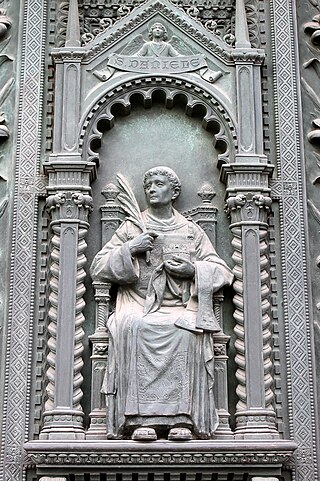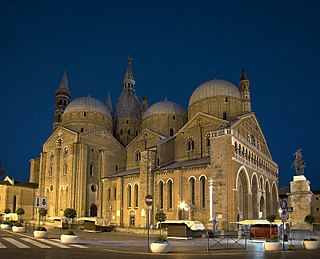
The Papal Basilica of Saint Peter in the Vatican, or simply Saint Peter's Basilica, is a church of the Italian High Renaissance located in Vatican City, an independent microstate enclaved within the city of Rome, Italy. It was initially planned in the 15th century by Pope Nicholas V and then Pope Julius II to replace the ageing Old St. Peter's Basilica, which was built in the fourth century by Roman emperor Constantine the Great. Construction of the present basilica began on 18 April 1506 and was completed on 18 November 1626.

Anthony of Padua, OFM, or Anthony of Lisbon was a Portuguese Catholic priest and member of the Order of Friars Minor.

Mary, Queen of the World Cathedral or in full Mary, Queen of the World and St. James the Great Cathedral is a minor basilica in Montreal, Quebec, Canada, and the seat of the Roman Catholic Archdiocese of Montreal. It is the third largest church in Quebec after Saint Joseph's Oratory and the Basilica of Sainte-Anne-de-Beaupré east of Quebec City. The building is 101 m (333 ft) in length, 46 m (150 ft) in width, and a maximum height of 77 m (252 ft) at the cupola, the diameter of which is 23 m (75 ft).

Arnolfo di Cambio was an Italian architect and sculptor of the Duecento, who began as a lead assistant to Nicola Pisano. He is documented as being capomaestro or Head of Works for Florence Cathedral in 1300, and designed the sixth city wall around Florence (1284–1333).

Alessandro Bonvicino, more commonly known as Moretto, or in Italian Il Moretto da Brescia, was an Italian Renaissance painter from Brescia, where he also mostly worked. His dated works span the period from 1524 to 1554, but he was already described as a master in 1516. He was mainly a painter of altarpieces that tend towards sedateness, mostly for churches in and around Brescia, but also in Bergamo, Milan, Verona, and Asola; many remain in the churches they were painted for. The majority of these are on canvas, but a considerable number, including some large pieces, are created on wood panels. There are only a few surviving drawings from the artist.

Sebastiano Ricci was an Italian Baroque painter of the late Baroque period in Venetian painting. About the same age as Piazzetta, and an elder contemporary of Tiepolo, he represents a late version of the vigorous and luminous Cortonesque style of grand manner fresco painting.

Santhome is a locality in Mylapore in Chennai city in India.

The Arca di San Domenico is a monument containing the remains of Saint Dominic. It is located in Dominic’s Chapel in the Basilica of San Domenico in Bologna, Italy.

Justina of Padua is a Christian saint and a patroness of the city of Padua. Her feast day is October 7. She was devoted to religion from her earliest years and took the vow of perpetual virginity. When she was brought before Maximian the prefect, she remained firm against all attacks. The prefect caused her to be slain with the sword.

Saint Daniel of Padua is venerated as the deacon of Saint Prosdocimus, the first Bishop of Padua.

The Pontifical Basilica of Saint Anthony of Padua is a Catholic church and minor basilica in Padua, Veneto, Northern Italy, dedicated to St. Anthony of Padua.

Vannes Cathedral is a Roman Catholic church dedicated to Saint Peter in Vannes, Brittany, France. The cathedral is the seat of the Bishop of Vannes.

Padua Cathedral, or Basilica Cathedral of Saint Mary of the Assumption, is a Catholic church and minor basilica located on the east end of Piazza Duomo, adjacent to the bishop's palace in Padua, Veneto, Italy.

San Francesco della Vigna is a Roman Catholic church in the Sestiere of Castello in Venice, northern Italy.

Isidoro Bianchi called da Campione was an Italian painter of the Baroque period.

Piacenza Cathedral, fully the Cathedral of Santa Maria Assunta e Santa Giustina, is a Roman Catholic cathedral in Piacenza, Italy. The current structure was built between 1122 and 1233 and is one of the most valuable examples of a Romanesque cathedral in northern Italy. The dedication is to the Assumption of the Virgin Mary and to Saint Justina. It is the seat of the diocese of Piacenza-Bobbio.

The Abbey of Santa Giustina is a 10th-century Benedictine abbey complex located in front of the Prato della Valle in central Padua, region of Veneto, Italy. Adjacent to the former monastery is the basilica church of Santa Giustina, initially built in the 6th century, but whose present form derives from a 17th-century reconstruction.

Santa Sofia is the oldest Roman Catholic church structure in the city of Padua, region of Veneto, Italy. It was built in the 10th century on the site of a presumed Mithraeum. A grant was made to bishop Sinibaldo of this church in 1123, which had already been in construction. The Romanesque stone and brick facade was constructed from 1106 to 1127, but the semicircular apse may date from earlier. The interior is now relatively bare.

San Daniele is a Roman Catholic church and monastery in Padua, region of Veneto, Italy.




















